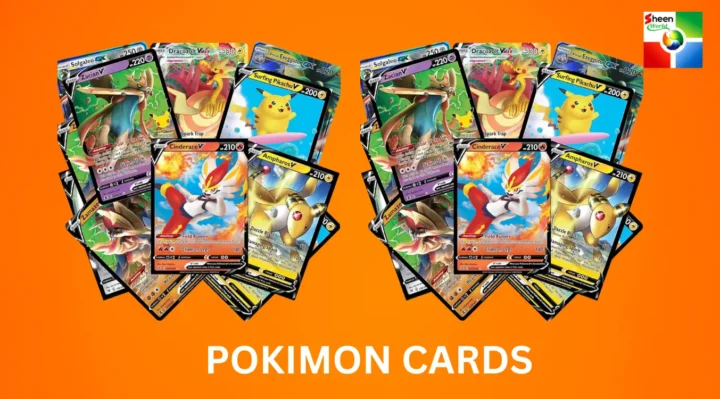
At A glance Pokémon Cards
The world of Pokémon cards is vast and exciting, captivating millions of fans across generations. From the initial release in the late 1990s to its current status as a cultural phenomenon, Pokémon cards have evolved into a hobby that combines strategy, nostalgia, and investment opportunities. In this comprehensive guide, we will explore everything you need to know about Pokémon cards, from collecting and playing to their role as investment assets.
What Are Pokémon Cards?
The Basics of Pokémon Cards
Pokémon cards are collectible trading cards that feature various Pokémon characters, moves, and abilities. Each card provides unique gameplay mechanics and contributes to the overall strategy of the Pokémon Trading Card Game (TCG). The cards are divided into several categories, including Pokémon cards, Trainer cards, and Energy cards.
Types of Pokémon Cards
- Pokémon Cards: These cards represent the Pokémon you can use in battles. They come in different rarities and types, including Basic Pokémon and Stage 1 and Stage 2 Pokémon.
- Trainer Cards: These cards represent items, supporters, and stadiums that can assist players during battles. They are crucial for enhancing gameplay strategies.
- Energy Cards: These cards provide the necessary energy to use Pokémon attacks. They come in various types, corresponding to the Pokémon’s elemental types.
The History of Pokémon Cards
The Birth of Pokémon Trading Cards
Pokémon cards were first introduced in Japan in 1996, created by Satoshi Tajiri and Ken Sugimori. The game quickly gained popularity, leading to an international release in 1999. The original set, known as Base Set, featured 102 cards and included iconic Pokémon like Charizard, Pikachu, and Blastoise.
Evolution of the Game
Over the years, the Pokémon Trading Card Game has evolved significantly. New sets are released regularly, introducing new mechanics, Pokémon, and gameplay strategies. Notable expansions include the Gym Heroes series, the Neo series, and the Sun & Moon series, each contributing to the game’s complexity and depth.
How to Collect Pokémon Cards
Starting Your Collection
- Choose Your Focus: Decide if you want to collect specific Pokémon, sets, or card types. Some collectors focus on rare cards, while others may collect based on their favorite characters.
- Research and Learn: Familiarize yourself with the different sets and their values. Online resources, forums, and price guides can help you understand the market.
- Find Reliable Sources: Purchase cards from reputable sellers, whether it be online marketplaces, local game stores, or trading events. Always verify the authenticity of the cards.
Organizing Your Collection
- Storage Solutions: Use binders, sleeves, and boxes to protect your cards from damage. Proper storage is essential for maintaining the value of your collection.
- Cataloging: Keep a record of your collection, noting the condition and value of each card. This can help when trading or selling in the future.
Trading and Selling Pokémon Cards
- Join Communities: Engage with local and online communities to find trading partners. Social media groups, forums, and local game shops are great places to connect with other collectors.
- Understand Market Trends: Monitor the market for fluctuations in prices. Certain cards may gain value due to popularity, competitive play, or nostalgic significance.
Playing the Pokémon Trading Card Game
Getting Started with Gameplay
- Learn the Rules: Familiarize yourself with the basic rules of the Pokémon TCG. Understanding the turn structure, card types, and win conditions is crucial for effective gameplay.
- Build Your Deck: A standard deck consists of 60 cards, including Pokémon, Trainer, and Energy cards. Balance and synergy are key to creating a competitive deck.
- Practice: Play with friends or at local game stores to gain experience and refine your strategy. Practice helps you learn card interactions and improve your gameplay.
Advanced Strategies
- Deck Archetypes: Explore different deck archetypes, such as Aggro, Control, and Combo. Each archetype has its strengths and weaknesses, influencing gameplay strategies.
- Card Synergies: Understanding how cards interact can enhance your strategy. Look for combinations that maximize your chances of winning.
- Adaptability: Stay flexible during matches. Adjust your strategy based on your opponent’s deck and playstyle.
The Investment Potential of Pokémon Cards
Why Invest in Pokémon Cards?
- Market Growth: The Pokémon card market has seen significant growth in recent years, with some cards selling for thousands of dollars. This trend indicates a robust demand for rare and nostalgic cards.
- Cultural Significance: As Pokémon continues to be a beloved franchise, the value of its merchandise, including cards, is likely to remain strong.
- Diversification: Investing in Pokémon cards can diversify your investment portfolio, offering a unique asset class.
Identifying Valuable Cards
- Rarity and Condition: Cards with limited print runs or unique features are often more valuable. Additionally, the condition of the card (graded by companies like PSA or Beckett) significantly affects its market value.
- Popular Characters: Cards featuring iconic Pokémon, such as Charizard or Pikachu, tend to hold their value better than others.
- Promotional and Event Cards: Limited-edition promotional cards from events or tournaments can be highly sought after by collectors.
Buying and Selling Strategies
- Research Current Values: Use online marketplaces and auction sites to gauge the current market value of specific cards.
- Timing the Market: Selling cards at peak demand times, such as during major Pokémon events or anniversaries, can yield higher prices.
- Networking: Build relationships with other collectors and investors. Networking can lead to valuable trades and sales opportunities.
The Future of Pokémon Cards
Trends in Collecting and Gameplay
- Digital Integration: The rise of digital TCG platforms may influence traditional collecting and gameplay. Pokémon has already introduced online platforms like Pokémon TCG Online, bridging the gap between physical and digital cards.
- Community Events: As the Pokémon community continues to grow, expect more local events, tournaments, and conventions that celebrate the Pokémon TCG.
- Innovative Card Designs: The Pokémon Company is likely to continue experimenting with card designs and mechanics, keeping the game fresh and engaging.
Sustainability and Preservation
- Environmental Concerns: As awareness of environmental issues grows, the Pokémon Company may explore sustainable practices in card production and packaging.
- Preserving Nostalgia: The enduring appeal of Pokémon ensures that the franchise will remain relevant for future generations, thus preserving the value of cards.
Conclusion
The world of Pokémon cards offers something for everyone, from casual collectors to serious investors. Understanding the nuances of collecting, playing, and investing in Pokémon cards can enhance your experience and potentially lead to valuable returns. Whether you’re diving into the nostalgia of childhood or exploring the strategic aspects of gameplay, Pokémon cards continue to enchant and engage fans around the globe. So grab your cards, gather your friends, and embark on your Pokémon journey today!
This guide provides a comprehensive overview of Pokémon cards, covering collecting, gameplay, and investment strategies. Enjoy your exploration of this vibrant and exciting hobby!



